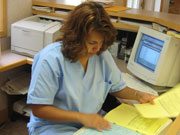   |
|
Bleach Your Teeth Crowns Dental Anesthesia Dental Implants Dentures: Get Your Smile Back Extraction of Wisdom Teeth Flossing Fluoride and Your Health Night Guards/Splints Nutrition & Dental Health Oral Cancers Porcelain Laminate Veneers Pregnancy and Oral Health Root Canal Therapy Temporomandibular Disorders TMJ/TMD The Right Time for Braces Tooth Decay: A Preventable Disease Women's Dental Health Your Child's First Dental Visit Your Child's Teeth and Gums: Tips for Parents |
What's baby bottle tooth decay? Baby bottle tooth decay is caused by the frequent and long-term exposure of a child's teeth to liquids containing sugars. Among these liquids are milk, formula, fruit juice, sodas, and other sweetened drinks. The sugars in these liquids pool around the infant's teeth and gums, feeding the bacteria that cause plaque. Every time a child consumes a sugary liquid, acid attacks the teeth and gums. After numerous attacks, tooth decay can begin. The condition also is associated with breast-fed infants who have prolonged feeding habits or with children whose pacifiers are frequently dipped in honey, sugar or syrup. The sweet fluids left in the mouth increases the chances of cavities while the infant is sleeping. How can I prevent baby bottle tooth decay? Never allow children to fall asleep with a bottle containing milk, formula, juice or other sweetened liquids. Clean and massage the baby's gums to help establish healthy teeth and to aid in teething. Wrap a moistened gauze square or wash cloth around the finger and gently massage the gums and gingival tissues. This should be done once a day. Plaque removal activities should begin upon eruption of the first baby tooth. When brushing a child's teeth, use a soft toothbrush and a pea-shaped amount of fluoride toothpaste. Parents should first bring their child to the dentist when the child is between six and 12 months old. Will changes in my child's diet help prevent baby bottle tooth decay? Preventing baby bottle tooth decay involves changes in a child's diet. A series of small changes over a period of time is usually easier, and eventually leads to better oral health. To incorporate these changes: • Gradually dilute the bottle contents with water over a period of 2-3 weeks. • Once that period is over, if you give a child a bottle, fill it with water or give the child a clean pacifier recommended by a dentist. ††††† The only safe liquid to put in a bottle to prevent baby bottle tooth decay is water. • Decrease consumption of sugar, especially between meals. • Children should be weaned from the bottle as soon as they can drink from a cup, but the bottle should not be taken away too soon, since the sucking motion aids in the development of facial muscles, as well as the tongue. Why should I be worried about baby bottle tooth decay? Giving an infant a sugary drink at nap or night time is harmful because during sleep, the flow of saliva decreases, allowing the sugary liquids to linger on the child's teeth for an extended period of time. If left untreated, pain and infection can result. Severely decayed teeth may need to be extracted. If teeth are infected or lost too early due to baby bottle tooth decay, your child may develop poor eating habits, speech problems, crooked teeth, and damaged adult teeth. Healthy baby teeth will usually result in healthy permanent teeth. Sources: "Prevent baby bottle syndrome," DentalNotes, December 1997; "Nursing caries: an overview," Connecticut State Dental Journal, Fall 1990; "A child's sleeping habit as a cause of nursing canes ", Journal of Dentistry for Children, January-February 1993; "Management of rampant caries in children," Cynthia K. Y. Yiu, Stephen H. Y. Wei, Quintessence International, Volume 23, Number 3, March 1992; Dr. Terry Dickinson; "The assessment of nursing caries and its relationship to high caries in the permanent dentition," Journal of Public Health, Winter 1992; "Dentistry for the child and adolescent," Ralph E. McDonald, DDS, MS, David R. Avery, DDS, 1994, Mosby-Year Book; The Dental Consumer Advisor: Information for the Dental Consumer; IFIC Review, May 1998, International Food Information Council Foundation. "Prevent baby bottle syndrome," DentalNotes, December 1997; "Nursing caries: an overview," Connecticut State Dental Journal, Fall 1990; "A child's sleeping habit as a cause of nursing canes ", Journal of Dentistry for Children, January-February 1993; "Management of rampant caries in children," Cynthia K. Y. Yiu, Stephen H. Y. Wei, Quintessence International, Volume 23, Number 3, March 1992; Dr. Terry Dickinson; "The assessment of nursing caries and its relationship to high caries in the permanent dentition," Journal of Public Health, Winter 1992; "Dentistry for the child and adolescent," Ralph E. McDonald, DDS, MS, David R. Avery, DDS, 1994, Mosby-Year Book; The Dental Consumer Advisor: Information for the Dental Consumer; IFIC Review, May 1998, International Food Information Council FoundationThis information was compiled for you by the Academy of General Dentistry. Your dentist cares about long-term dental health for you and your family and demonstrates that concern by belonging to the Academy of General Dentistry. As one of the 35,000 general dentists in the United States and Canada who are members of the Academy, your dentist participates in an ongoing program of professional development and continuing education to remain current with advances in the profession and to provide quality patient treatment. Visit the AGD's website at www.agd.org. You have permission to photocopy this page and distribute it to your patients. ¬† AGD IMPACT December, 1998 Posted†† October† 1,† 2000 † [TCJ] |
Questions - Comments - Suggestions
Should you have questions about any aspect of dental disease or treatment, or,
have a specific problem or treatment need, contact us at:
Phone: 1.707.255.3007 or E-Mail: dentist@johnsondmd.com
Address: 3434 Villa Lane, Suite #100; Napa, CA. 94558
© Copyright 2007, Thomas C. Johnson, DMD, Inc. All Rights Reserved.
